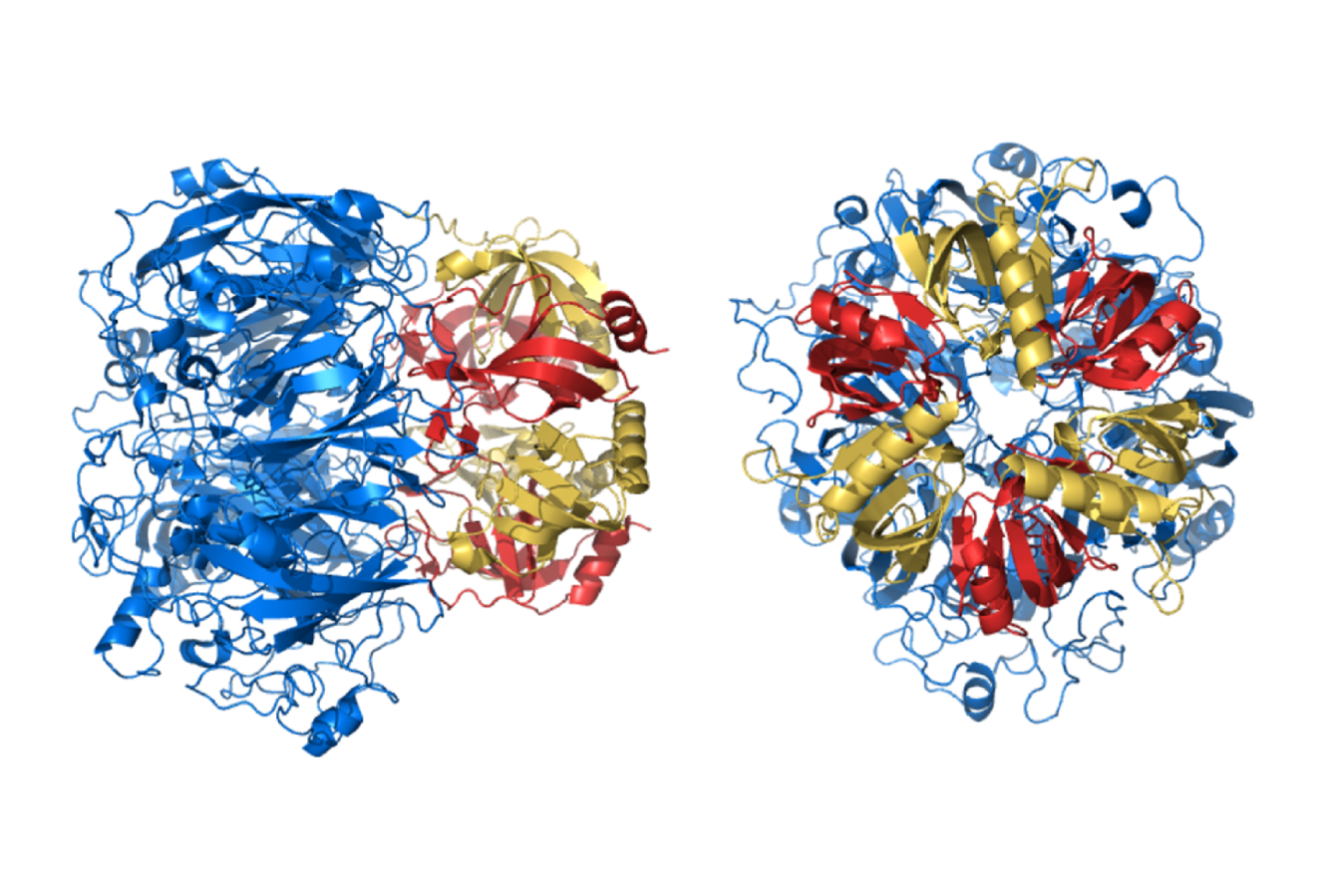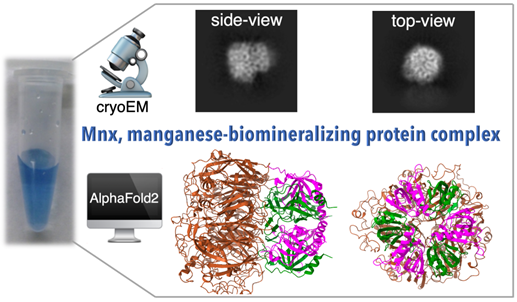Functional and Systems Biology
Cryo-Electron Microscopy and AlphaFold2 Prediction Reveals the Structure of the Mnx Protein Complex and Uncovers the Mechanism of Manganese Biomineralization
The 3-D structure of the Mnx protein complex has eluded crystallization efforts, but new approaches show a tunnel runs through the protein complex that enables biomineralization.

The structure of the first purified manganese-oxidizing protein Mnx, obtained using cryo-electron microscopy coupled with AlphaFold2 Multimer prediction, reveals a tunnel running through the multi-subunit complex. (Image courtesy of Spiro Lab)
The Science
The global manganese cycle moves manganese between the geosphere, hydrosphere, and biosphere, supporting life through the manganese centers of many biological molecules, or enzymes, including those in green plants that produce oxygen. The cycle is facilitated by manganese-oxidizing bacteria that bind dissolved manganese and convert it to insoluble manganese oxide minerals. These minerals help adsorb many toxic and essential elements, in turn controlling the distribution and bioavailability of other essential, as well as toxic, elements. Mnx, a protein complex and the first enzyme solely responsible for manganese oxide formation, was purified in 2012, but in the absence of structural details, little was known about how the enzyme worked at the molecular level. Combining information from a suite of cutting-edge instruments housed at the Environmental Molecular Sciences Laboratory (EMSL), a Department of Energy Office of Science user facility, a multi-institutional and multi-disciplinary team determined the 3-D structure of the Mnx enzyme, providing important insights into the mechanism of manganese oxide mineral formation by this novel enzyme.
The Impact
The reported structure of Mnx is the first atomic-level resolution structure of a manganese-biomineralization enzyme, made possible by the cryo-electron microscopy (cryo-EM) and advanced visual proteomics capabilities available at EMSL and the use of AlphaFold2 Multimer prediction. The structure informs long-standing questions in biogeochemistry, offering a platform to study how the Mnx protein complex catalyzes manganese biomineralization. The results of this work will guide future efforts toward new biotechnologies for the use of manganese oxides in clean water technologies, as catalysts in energy storage, and as water-splitting systems to generate electricity.
Summary
Manganese is one of the important redox-active metals in the Earth’s biosphere. It plays an essential biological role as a cofactor of enzymes, most notably of those involved in oxygen metabolism: Mn catalase and Mn-superoxide dismutase, which detoxify reactive oxygen species, and photosystem II that produces oxygen. The global manganese cycle relies on microbes to oxidize soluble Mn(II) to insoluble Mn(IV) oxides. Some microbes require peroxide or superoxide as oxidants, but others can use oxygen directly via multicopper oxidase enzymes. One of these, MnxG from Bacillus sp. strain PL-12, was previously isolated in tight association with small accessory proteins, MnxE and MnxF, as a complex called Mnx. However, this protein complex has eluded crystallization efforts. Using novel multimodal capabilities at EMSL, including cryo-EM single particle analysis, cross-linking mass spectrometry, and AlphaFold2 Multimer prediction, a multi-institutional team of researchers revealed the 3-D structure of Mnx. The complex features the MnxG enzyme, capped by a heterohexameric ring of alternating MnxE and MnxF subunits, and a tunnel that runs through MnxG and its MnxE3F3 cap. The tunnel dimensions and charges can accommodate the mechanistically inferred binuclear manganese intermediates. The 3-D structure provides a rationale for the established manganese oxidase mechanism and a platform for further experiments to elucidate mechanistic details of manganese biomineralization.
Contacts
Bradley Tebo, University of Washington, tebob@ohsu.edu
Thomas Spiro, University of Washington, spirot@uw.edu
James Evans, EMSL, james.evans@pnnl.gov
Funding
This work was supported by the Division of Chemistry and the Division of Earth Sciences of the National Science Foundation. The cryo-EM and mass spectrometry work were performed as part of the Large-Scale Research award from the Environmental Molecular Science Laboratory (EMSL), a Department of Energy (DOE) Office of Science user facility sponsored by the Biological and Environmental Research program.
Publication
I.V. Novikova, et al. “Cryo-EM structure of the Mnx protein complex reveals a tunnel framework for the mechanism of manganese biomineralization.” Journal of the American Chemical Society 146, 22950−22958 (2024). [DOI: 10.1021/jacs.3c06537]


